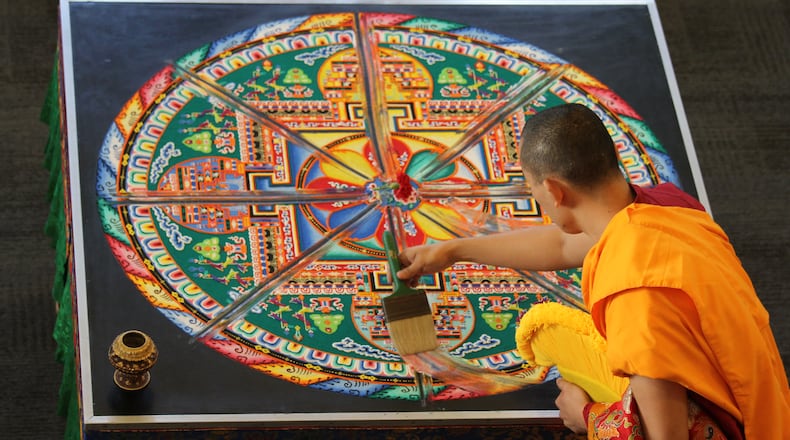Imagine spending more than 30 hours painstakingly detailing an elaborate piece of art, finally perfecting the work, then destroying it merely hours later.
That is what a group of seven Tibetan Buddhist monks from the Drepung Loseling Monastery in Atlanta did at Oxford College Library near Covington.
The construction of an elaborate sand mandala was live-streamed online throughout the week of Feb. 20 as the monks worked eight hours a day Monday through Friday. The piece of artwork was finished only Friday morning before its destruction during a ritualistic ceremony the same day at noon.
Mandalas are geometric pieces of art that symbolize the universe in Hinduism and Buddhism. This mandala was handcrafted and made purely of sand.
“Traditionally, mandalas are created for the purpose of invoking a specific deity and to assist meditators who are being initiated into the meditation on that deity,” Geshe Nyima Tsering, a spokesman for the group, said prior to the closing ceremony. “This mandala was not constructed in that context. However, all the guidelines and instructions for creating a mandala have been strictly observed.”
The monks consecrated the site in the opening ceremony on Monday with meditation and ritual chants. Then, during the course of making the mandala, they maintained a meditative mindfulness on the purpose of its creation.
The monks visited with curious students and faculty who both watched its construction with carefully placed colored sand, followed by its rapid demise. A lecture titled “Symbolism of the Sand Mandala in Buddhism” was also presented that week.
Credit: Kay Hinton
Credit: Kay Hinton
“I hope that my students learned something about Buddhism, Buddhist virtues, ethics and symbolism,” said Dr. Eve Mullen, associate professor of religion at Oxford College. “And I hope they learned something about rituals in general.”
While the mandala met its end during the ritual, the destruction itself was rather artistic. The monks chanted and played instruments including two large horns, cymbals, bells and a large drum, while meticulously altering the structure.
One monk used a single finger to draw lines in the circular artwork, cutting it into four slices, then eight. A second then took a paintbrush and carved broad strokes into the sand, eventually rendering it an unrecognizable rainbow of color.
When it was all over, students were allowed to take bits of the sand in tiny bags as souvenirs.
Over the years monks have created and destroyed sand mandalas at Emory University’s main campus in Druid Hills, but this was the first time they had done so at the Oxford College campus.
Credit: Oxford College of Emory University
Credit: Oxford College of Emory University
"Emory University has a relationship with the Drepung Loseling Monastery, and they have through the Mystical Arts of Tibet constructed mandalas before," said Mullen. "This is the first time they've visited our campus, which is a big deal for us. Our Tibetan Studies program at Emory is 17 years old now, so Emory's partnership with Tibetan culture has been going on for some time."
The purpose of the ancient ritual is to symbolize the transitory nature of material life.
“One of the main Buddhist concepts to keep in mind is impermanence,” said Mullen. “The mandala is constructed to be dismantled immediately. That shows impermanence. It also should cultivate non-attachment in the person, including the artist making it. Making the mandala itself is meditation, it requires great concentration, and the symbolism contained in it is understood in the Tibetan tradition to empower the meditator.”
About the Author








